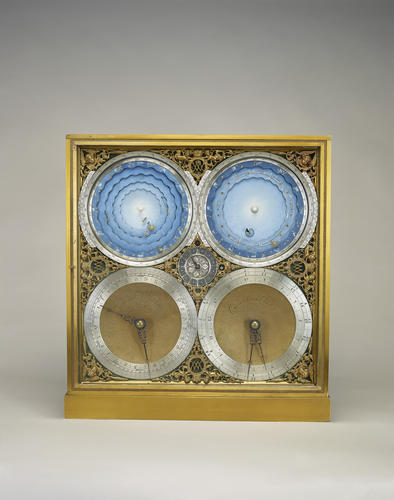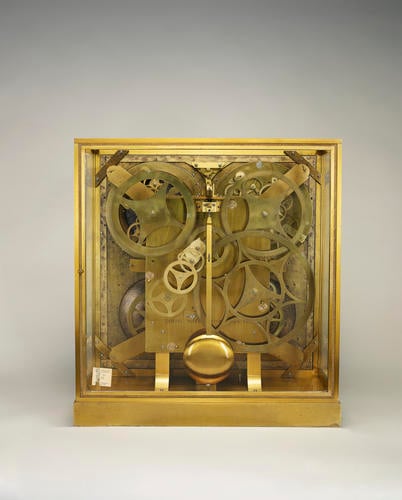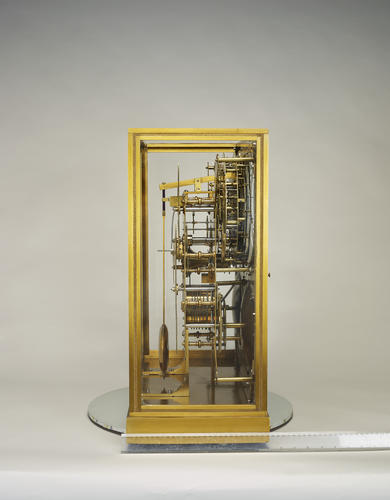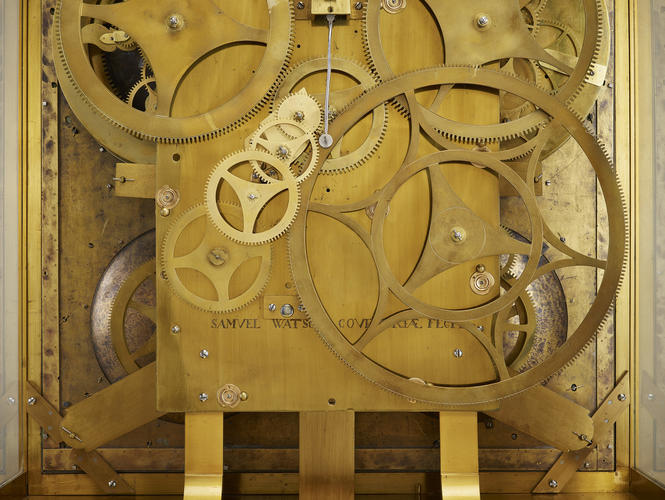-
1 of 253523 objects
Astronomical Clock 1683-90
Glass, brass and steel | 50.2 x 50.0 cm (whole object) | RCIN 30260

Samuel Watson (c. 1635-1710)
Astronomical Clock 1683-90

Samuel Watson (c. 1635-1710)
Astronomical Clock 1683-90

Samuel Watson (c. 1635-1710)
Astronomical Clock 1683-90

Samuel Watson (c. 1635-1710)
Astronomical Clock 1683-90

Samuel Watson (c. 1635-1710)
Astronomical Clock 1683-90

Samuel Watson (c. 1635-1710)
Astronomical Clock 1683-90






-
Five-dial astronomical clock for an observer in London facing south. The Planetary Dial on the upper left displays in concentric sub-dials of graduated shades of blue the five planets then known (Sun, Mercury, Venus, Mars and Jupiter), the 12 signs of the Zodiac with their principal stars, the 24 hours of the day and the 360° of terrestial longitude. To the upper right the Lunar Dial, after Copernicus, is constructed similarly to the Planetary Dial and has the Earth to the centre with, originally, the Moon revolving around the earth and within its own revolve. The two lower dials are matted and gilded and deeply set. The lower left Calendar and Solar Cycle Dial with the long hand reolving annually giving the day of the month, the second circle shows the month of the year and days in each month; the solar cycle is the period of time at the end of which the days of the week recur in the Julian Calendar. The Dial of the Golden Numbers on the lower right records first the 15-year Roman Indication cycle, second the 19-year Metonic cycle - the period of solar years exactly divisible by the complete number of lunations - and the outer third circle the Epact - the number of days in the solar year in excess of the nearest exact number of lunations. The small centre dial records the hour of the day and the day of the week. All are mounted in gilt bronze pierced spandrels cast decorated with seraphs and putti holding, at the centre of each side, pierced and intertwined ciphers of William and Mary. Originally presented in a long case but now mounted into a case by Jump & Sons of Mount Street in 1907.
Provenance
Samuel Watson lived and worked as a 'watchmaker' in Coventry and Long Acre, London in the 17th century. Charles II had an astronomical clock by Watson at Whitehall bought for £215 in 1682. It is assumed this clock was destroyed in the fire of 1698. In 1683 The King ordered a more elaborate astronomical clock from Watson intended for his closet at Whitehall. 'This very curious piece of workmanship ... far exceeds any Piece of Clockwork prior to it, whose Description I have met with. It was begun in 1683 by command of His Majesty King Charles II for his own immediate service, but was not completed till 1690; which being several years after the Death of his said Majesty. Mr. Watson published Proposals for deposing of it by way of Lot, dividing the whole, into one hundred Chances at ten pounds each. ... The foregoing proposals were never put in execution; for soon after the Publication of them, I find this Piece of Clockwork was purchased by Queen Mary; and was fixed up in His Majesty's Palace at Kensington, where it continues at present.' [Extract from 'A description of a piece of Clockwork called by its Inventor and Maker a Chronological Automaton or Self-moving Ephemeris, invented and made by Samuel Watson of Coventry, watchmaker.' British Museum: Catalogue of Western Manuscripts in the old Royal & King's collections' c.1790.] The clock was originally contained in a 3-train long case - which survives elsewhere - but was probably dismantled by Queen Mary and mounted in panelling. It was known to be in Queen Mary II's possession at the date of her death in 1694: 'The queen hath a Clock made by Mr. Watson, late of Coventry, worth 1,000 1, in which are all the Motions of the Celestial Bodies.' [Chamberlayne's 1694 Edition of Angliae Notitia (p.51)]. In 1907 the clock was restored and glazed by Jump & Sons of 93 Mount Street whe the one-second beating pendulum was removed and a ⅔ second substituted. This involved a new spring driven going train - the clock was originally weight driven. The clock was returned to Windsor Castle.
-
Creator(s)
(clockmaker)(clockmaker) -
Medium and techniques
Glass, brass and steel
Measurements
50.2 x 50.0 cm (whole object)
Alternative title(s)
Wall hung clock